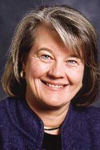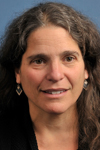Three health experts offer ideas on how states can identify and enroll the 5 million children who are uninsured but eligible for Medicaid and the Children’s Health Insurance Program and the millions of uninsured adults who will become eligible for Medicaid in 2014 under the new health overhaul law.
 Alice Weiss, program director of the National Academy for State Health Policy in Washington D.C.
Alice Weiss, program director of the National Academy for State Health Policy in Washington D.C.
Weiss says Massachusetts’ experience shows that requiring individuals to obtain insurance isn’t enough to get everyone signed up for coverage. In the three years after the state enacted its mandate in 2006, the uninsured portion of the population dropped from 9 percent to 3 percent. She credits a massive marketing campaign that included advertising during Red Sox games at Fenway Park in Boston and at pharmacies.
Simplifying enrollment in Medicaid is a key step. She advocates “express lane eligibility,” which gives states the option to certify children for health coverage based on records of other government agencies, including those that administer food stamp and subsidized lunch programs. Eighteen states are pursuing this strategy, which Congress authorized in 2009, she said.
More From This Special Report
She said states also need a one-stop system for coverage so people can go to the same place to sign up for insurance in Medicaid or the new insurance exchanges, or marketplaces, that open in 2014.
Other steps might include developing a joint Medicaid and Children’s Health Insurance Program (CHIP) application, offering an online application, allowing one year of eligibility rather than six months and eliminating an in-person interview.
“It is critically important that even with a mandate, people find a coverage system they understand, that works in a logical way to promote enrollment and not have a huge bureaucracy,” Weiss said.
 Tricia Brooks, senior fellow at the Center for Children and Families at the Georgetown University Health Policy Institute in Washington D.C.
Tricia Brooks, senior fellow at the Center for Children and Families at the Georgetown University Health Policy Institute in Washington D.C.
“People need multiple ways to apply for coverage, on the Web, on the phone and through the mail and through extensive personalized assistance,” said Brooks, former director of the CHIP program in New Hampshire.
“The barriers that people face accessing health coverage will continue to exist, whether it’s children or adults: lack of awareness, literacy issues, cultural barriers. We still will have all those issues even when health reform expansion takes place.”
She said states need to tap existing data from food stamp and other programs to find people who qualify for coverage, although that’s no guarantee they’ll get signed up. She noted that New Jersey last year found thousands of uninsured children who were eligible for Medicaid or CHIP by using state income tax records. But instead of automatically enrolling them, the state sent the parents an application, which many did not return.
 Diane Rowland, executive vice president of the Kaiser Family Foundation and executive director of the Kaiser Commission on Medicaid and the Uninsured.
Diane Rowland, executive vice president of the Kaiser Family Foundation and executive director of the Kaiser Commission on Medicaid and the Uninsured.
The individual insurance mandate will help states and the federal government “create a culture of coverage” in which everyone is expected to have health insurance, she said. Part of the effort should include renaming Medicaid so it sounds less like a welfare program and more like comprehensive health coverage: “An appealing name that entices people is critical.” Rowland suggests two options, “Healthy U.S.” or “Comprehensive Health Insurance Program.”
Some states have already done this, using familiar nicknames. Oklahoma calls its Medicaid program “SoonerCare,” and Connecticut uses the name “Husky” for its CHIP program.
States can learn a lot about enrolling adults in Medicaid from current efforts to enroll children in that program and CHIP, Rowland said. “Parents can be reached through many of the children,” she said, including events at schools and health fairs.
States need to focus not only on enrolling adults and children but also on making it easy for them to renew their Medicaid coverage.
The health law will support simplification efforts by eliminating the asset test that many states apply when determining Medicaid eligibility for adults. Nearly all states have already dropped it for kids, Rowland said. The law also expands the states’ ability to use “presumptive eligibility,” which allows doctors and others to enroll patients in Medicaid even though they may not immediately have all the required documentation. (KHN is a project of the Kaiser Family Foundation.)
 Donna Cohen Ross, senior adviser, Office of External Affairs, Centers for Medicare and Medicaid Services. She was interviewed in March when she was director of outreach for the Center on Budget and Policy Priorities in Washington.
Donna Cohen Ross, senior adviser, Office of External Affairs, Centers for Medicare and Medicaid Services. She was interviewed in March when she was director of outreach for the Center on Budget and Policy Priorities in Washington.
Cohen Ross said Louisiana has shown how state Medicaid and CHIP programs can work with other state agencies to identify thousands of uninsured children who are eligible for coverage. Earlier this year, Louisiana identified 10,000 children on its food stamp rolls who were eligible but not enrolled in Medicaid or CHIP.
“The whole point behind express lane eligibility is simply acknowledging that the vast majority of kids qualify and why ask families to go through the paperwork-intensive process when you already have just about all the proof of coverage from other programs,” said Cohen Ross.
Under current federal law, express lane eligibility can only be used for enrolling children. But she suggested Congress might consider expanding it for adults.
Cohen Ross said some states have had success paying incentive payments to nonprofit social service agencies and groups that help enroll kids in Medicaid and CHIP.
Oregon, which is paying $50 for each successful applicant, this spring became the latest state to adopt this strategy. Illinois, Indiana, California, Louisiana and New Hampshire have enrolled hundreds of thousands using this approach over the past few years.
“We know what we need to do because we have been at this for over a decade,” Cohen Ross said. “Now we have a challenge to do it,” she said, referring to the Obama administration’s goal to enroll all 5 million uninsured children who are eligible for Medicaid and CHIP.






